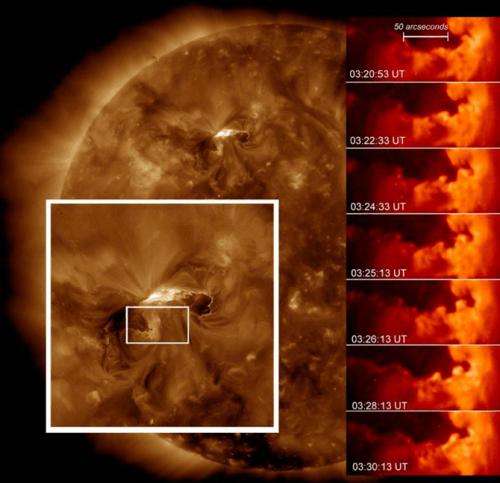Solar Dynamics Observatory catches 'surfer' waves on the Sun (w/ video)

(PhysOrg.com) -- Cue the surfing music. Scientists have spotted the iconic surfer's wave rolling through the atmosphere of the sun. This makes for more than just a nice photo-op: the waves hold clues as to how energy moves through that atmosphere, known as the corona.
Since scientists know how these kinds of waves -- initiated by a Kelvin-Helmholtz instability if you're being technical -- disperse energy in the water, they can use this information to better understand the corona. This in turn, may help solve an enduring mystery of why the corona is thousands of times hotter than originally expected.
"One of the biggest questions about the solar corona is the heating mechanism," says solar physicist Leon Ofman of NASA's Goddard Space Flight Center, Greenbelt, Md. and Catholic University, Washington. "The corona is a thousand times hotter than the sun's visible surface, but what heats it up is not well-understood. People have suggested that waves like this might cause turbulence which cause heating, but now we have direct evidence of Kelvin-Helmholtz waves."
Ofman and his Goddard colleague, Barbara Thompson, spotted these waves in images taken on April 8, 2010. These were some of the first images caught on camera by the Solar Dynamics Observatory (SDO), a solar telescope with outstanding resolution that launched on February 11, 2010 and began capturing data on March 24 of that year. The team's results appeared online in Astrophysical Journal Letters on May 19, 2011 and will be published in the journal on June 10.
That these "surfer" waves exist in the sun at all is not necessarily a surprise, since they do appear in so many places in nature including, for example, clouds on Earth and between the bands of Saturn. But observing the sun from almost 93 million miles away means it's not easy to physically see details like this. That's why the resolution available with SDO gets researchers excited.
"The waves we're seeing in these images are so small," says Thompson who in addition to being a co-author on this paper is the deputy project scientist for SDO. "They're only the size of the United States," she laughs.
On April 8, 2010, SDO recorded images of gas erupting through the sun's atmosphere that formed the froth covered, curly waves that look like surfing waves. Look for them rolling around the edges of the expanding dark spots. Credit: NASA/Goddard Space Flight Center
Kelvin-Helmholtz instabilities occur when two fluids of different densities or different speeds flow by each other. In the case of ocean waves, that's the dense water and the lighter air. As they flow past each other, slight ripples can be quickly amplified into the giant waves loved by surfers. In the case of the solar atmosphere, which is made of a very hot and electrically charged gas called plasma, the two flows come from an expanse of plasma erupting off the sun's surface as it passes by plasma that is not erupting. The difference in flow speeds and densities across this boundary sparks the instability that builds into the waves.
In order to confirm this description, the team developed a computer model to see what takes place in the region. Their model showed that these conditions could indeed lead to giant surfing waves rolling through the corona.
Ofman says that despite the fact that Kelvin-Helmholtz instabilities have been spotted in other places, there was no guarantee they'd be spotted in the sun's corona, which is permeated with magnetic fields. "I wasn't sure that this instability could evolve on the sun, since magnetic fields can have a stabilizing effect," he says. "Now we know that this instability can appear even though the solar plasma is magnetized."
Seeing the big waves suggests they can cascade down to smaller forms of turbulence too. Scientists believe that the friction created by turbulence – the simple rolling of material over and around itself – could help add heating energy to the corona. The analogy is the way froth at the top of a surfing wave provides friction that will heat up the wave. (Surfers of course don't ever notice this, as any extra heat quickly dissipates into the rest of the water.)
Hammering out the exact mechanism for heating the corona will continue to intrigue researchers for some time but, says Thompson, SDO's ability to capture images of the entire sun every 12 seconds with such precise detail will be a great boon. "SDO is not the first solar observatory with high enough visual resolution to be able to see something like this," she says. "But for some reason Kelvin-Helmholtz features are rare. The fact that we spotted something so interesting in some of the first images really shows the strength of SDO."
Provided by NASA's Goddard Space Flight Center




















